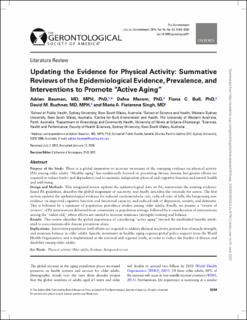| dc.contributor.author | Bauman, Adrian | |
| dc.contributor.author | Merom, Dafna | |
| dc.contributor.author | Bull, Fiona C. | |
| dc.contributor.author | Buchner, David M. | |
| dc.contributor.author | Singh, Maria A. Fiatarone | |
| dc.date.accessioned | 2020-06-03T11:18:50Z | |
| dc.date.available | 2020-06-03T11:18:50Z | |
| dc.date.issued | 2016 | |
| dc.identifier.citation | Bauman, A., Merom, D., Bull, F. C., Buchner, D. M., & Fiatarone Singh, M. A. (2016). Updating the evidence for physical activity: summative reviews of the epidemiological evidence, prevalence, and interventions to promote “active aging”. The Gerontologist, 56(suppl_2), 268-280. | en_US |
| dc.identifier.uri | https://hdl.handle.net/11250/2656352 | |
| dc.description.abstract | Purpose of the Study:
There is a global imperative to increase awareness of the emerging evidence on physical activity (PA) among older adults. “Healthy aging” has traditionally focused on preventing chronic disease, but greater efforts are required to reduce frailty and dependency and to maintain independent physical and cognitive function and mental health and well-being.
Design and Methods:
This integrated review updates the epidemiological data on PA, summarizes the existing evidence-based PA guidelines, describes the global magnitude of inactivity, and finally describes the rationale for action. The first section updates the epidemiological evidence for reduced cardiometabolic risk, reduced risks of falls, the burgeoning new evidence on improved cognitive function and functional capacity, and reduced risk of depression, anxiety, and dementia. This is followed by a summary of population prevalence studies among older adults. Finally, we present a “review of reviews” of PA interventions delivered from community or population settings, followed by a consideration of interventions among the “oldest-old,” where efforts are needed to increase resistance (strength) training and balance.
Results:
This review identifies the global importance of considering “active aging” beyond the established benefits attributed to noncommunicable disease prevention alone.
Implications:
Innovative population-level efforts are required to address physical inactivity, prevent loss of muscle strength, and maintain balance in older adults. Specific investment in healthy aging requires global policy support from the World Health Organization and is implemented at the national and regional levels, in order to reduce the burden of disease and disability among older adults. | en_US |
| dc.publisher | The Gerontologist | en_US |
| dc.subject | physical activity | en_US |
| dc.subject | older adults | en_US |
| dc.subject | evidence | en_US |
| dc.subject | integrated review | en_US |
| dc.title | Updating the Evidence for Physical Activity: Summative Reviews of the Epidemiological Evidence, Prevalence, and Interventions to Promote “Active Aging” | en_US |
| dc.type | Journal article | en_US |
| dc.source.pagenumber | 268-280 | en_US |
| dc.source.volume | 56 | en_US |
| dc.source.journal | The Gerontologist | en_US |
| dc.source.issue | Suppl_2 | en_US |
| dc.identifier.doi | https://doi.org/10.1093/geront/gnw031 | |
| dc.description.localcode | måsjekkes | |
